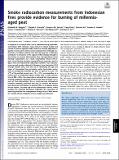| dc.contributor.author | Wiggins, Elizabeth B. | |
| dc.contributor.author | Czimczik, Claudia I. | |
| dc.contributor.author | Santos, Guaciara M. | |
| dc.contributor.author | Chen, Yang | |
| dc.contributor.author | Xu, Xiaomei | |
| dc.contributor.author | Holden, Sandra R. | |
| dc.contributor.author | Randerson, James T. | |
| dc.contributor.author | Harvey, Charles F | |
| dc.contributor.author | Kai, Fuu Ming | |
| dc.contributor.author | Yu, Liya E. | |
| dc.date.accessioned | 2020-06-05T15:08:26Z | |
| dc.date.available | 2020-06-05T15:08:26Z | |
| dc.date.issued | 2018-11 | |
| dc.date.submitted | 2018-05 | |
| dc.identifier.issn | 1091-6490 | |
| dc.identifier.issn | 0027-8424 | |
| dc.identifier.uri | https://hdl.handle.net/1721.1/125687 | |
| dc.description.abstract | In response to a strong El Niño, fires in Indonesia during September and October 2015 released a large amount of carbon dioxide and created a massive regional smoke cloud that severely degraded air quality in many urban centers across Southeast Asia. Although several lines of evidence indicate that peat burning was a dominant contributor to emissions in the region, El Niño-induced drought is also known to increase deforestation fires and agricultural waste burning in plantations. As a result, uncertainties remain with respect to partitioning emissions among different ecosystem and fire types. Here we measured the radiocarbon content ([superscript 14]C) of carbonaceous aerosol samples collected in Singapore from September 2014 through October 2015, with the aim of identifying the age and origin of fire-emitted fine particulate matter (particulate matter with an aerodynamic diameter less than or equal to 2.5 μm). The Δ[superscript 14]C of fire-emitted aerosol was −76 ± 51, corresponding to a carbon pool of combusted organic matter with a mean turnover time of 800 ± 420 y. Our observations indicated that smoke plumes reaching Singapore originated primarily from peat burning (∼85%), and not from deforestation fires or waste burning. Atmospheric transport modeling confirmed that fires in Sumatra and Borneo were dominant contributors to elevated PM2.5 in Singapore during the fire season. The mean age of the carbonaceous aerosol, which predates the Industrial Revolution, highlights the importance of improving peatland fire management during future El Niño events for meeting climate mitigation and air quality commitments. | en_US |
| dc.description.sponsorship | Gordon and Betty Moore Foundation (GBMF#3269) | en_US |
| dc.description.sponsorship | Singapore National Environment Agency (R-706-000-043-490) | en_US |
| dc.language.iso | en | |
| dc.publisher | Proceedings of the National Academy of Sciences | en_US |
| dc.relation.isversionof | https://doi.org/10.1073/pnas.1806003115 | en_US |
| dc.rights | Article is made available in accordance with the publisher's policy and may be subject to US copyright law. Please refer to the publisher's site for terms of use. | en_US |
| dc.source | PNAS | en_US |
| dc.title | Smoke radiocarbon measurements from Indonesian fires provide evidence for burning of millennia-aged peat | en_US |
| dc.type | Article | en_US |
| dc.identifier.citation | Wiggins, Elizabeth B. et al. “Smoke Radiocarbon Measurements from Indonesian Fires Provide Evidence for Burning of Millennia-Aged Peat.” Proceedings of the National Academy of Sciences 115, 49 (December 2018): 12419–24. © 2018 the Authors | en_US |
| dc.contributor.department | Massachusetts Institute of Technology. Department of Civil and Environmental Engineering | en_US |
| dc.relation.journal | Proceedings of the National Academy of Sciences of the United States of America | en_US |
| dc.eprint.version | Final published version | en_US |
| dc.type.uri | http://purl.org/eprint/type/JournalArticle | en_US |
| eprint.status | http://purl.org/eprint/status/PeerReviewed | en_US |
| dc.date.updated | 2020-05-27T14:29:53Z | |
| dspace.date.submission | 2020-05-27T14:29:57Z | |
| mit.journal.volume | 115 | en_US |
| mit.journal.issue | 49 | en_US |
| mit.license | PUBLISHER_POLICY | |
| mit.metadata.status | Complete | |
